Four Mile Dam Formation
The Four Mile Dam Formation, also called the Four Mile Dam Limestone, is a geologic formation in Michigan. It preserves fossils dating back to the middle Devonian period.

Stratigraphy of the Devonian deposits of the northern part of the Lower Peninsula of Michigan, showing the Four Mile Dam Formation[1]
| Four Mile Dam Formation | |
|---|---|
| Stratigraphic range: | |
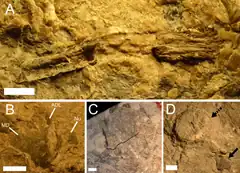 Vertebrate remains from the Four Mile Dam Formation. | |
| Type | Geological formation |
| Unit of | Traverse Group[1] |
| Lithology | |
| Primary | Limestone |
| Location | |
| Region | |
| Country | |
| Type section | |
| Named by | Cooper & Warthin[2] |
| Year defined | 1941[2] |
Fossil content
Acanthodians
| Acanthodians reported from the Four Mile Dam Formation | |||||
|---|---|---|---|---|---|
| Genus | Species | Presence | Material | Notes | Images |
| 'Acanthodii' | Unidentified | "Two partial fin spines (JS 120, JS 121)".[1] | "Distinct from named acanthodians (Gyracanthus, Machaeracanthus, and Oracanthus) and chondrichthyans (Tamiobatis and Acondylacanthus) reported from Michigan".[1] |  | |
Conodonts
| Conodonts reported from the Four Mile Dam Formation | |||||
|---|---|---|---|---|---|
| Genus | Species | Presence | Material | Notes | Images |
| Acodina | A. formosa | [3] | Also found in the Detroit River, Traverse, Dundee, Bell, Alpena and Norway Point formations. | ||
| Belodella | B. devonicus | [3] | Also found in the Detroit River, Traverse, Antrim, Alpena and Norway Point formations. | ||
| Icriodus | I. latericrescens latericrescens | [3] | Also found in the Traverse, Bell, Ferron Point, Genshaw, Newton Creek, Alpena, Norway Point, Potter Farm and Thunder Bay formations. | ||
| Ozarkodina | O. willsi | [3] | Also found in the Detroit River, Traverse, Antrim, Dundee, Alpena and Norway Point formations. | ||
| Polygnathus | P. varcus | [3] | Also found in the Traverse, Antrim, Alpena, Norway Point and Thunder Bay formations. | ||
Placoderms
| Placoderms reported from the Four Mile Dam Formation | |||||
|---|---|---|---|---|---|
| Genus | Species | Presence | Material | Notes | Images |
| ?Macropetalichthys | ?M. sp. | "A partial head shield (32M)".[1] | A petalichthyid. | 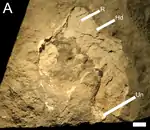 | |
| ?Mylostoma | ?M. sp. | 39 specimens, including potential juveniles.[1] | 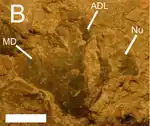 | ||
| 'Placodermi' | Unidentified | "One specimen of an armour plate (JS 4)".[1] | 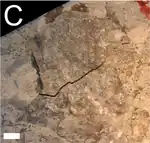 | ||
| Protitanichthys | P. rockportensis | "One specimen of an armor fragment (JS 101)".[1] | A coccosteid. | ||
Invertebrates
Color key
|
Notes Uncertain or tentative taxa are in small text; |
Brachiopods
| Brachiopods reported from the Four Mile Dam Formation | |||||
|---|---|---|---|---|---|
| Genus | Species | Presence | Material | Notes | Images |
| Douvillina | D. distans | Four Mile Dam, Thunder Bay River, Alpena County, Michigan.[4] | Also found in the Hungry Hollow Formation and Logansport Formation. | ||
| Leptalosia | L. radicans | Four Mile Dam, Thunder Bay River, Alpena County, Michigan.[4] | Also found in the Norway Point, Gravel Point, Alpena and Genshaw formations. | ||
| Longispina | L. emmetensis | Dock Street clay member.[4] | Also found in the Alpena Limestone and Gravel Point Formation. | ||
| Megastrophia | M. gibbosa | Four Mile Dam, Thunder Bay River, Alpena County, Michigan.[4] | Also found in the Hungry Hollow Formation and Logansport Formation. | ||
| Oligorhachis | O. oligorhachis | Four Mile Dam, Thunder Bay River, Alpena County, Michigan.[4] | Also found in the Gravel Point Formation. | ||
| Pentamerella | P. alpenensis | Dock Street clay member.[4] | Also found in the Alpena Limestone and Gravel Point Formation. | ||
| P. sp. C | Dock Street clay.[4] | A complete specimen.[4] | |||
| Protoleptostrophia | P. lirella | Dock Street clay member.[4] | Also found in the Norway Point Formation and Alpena Limestone. | ||
| Schuchertella | S. anomala | Possibly the Dock Street clay member.[4] | Also found in the Gravel Point Formation. | ||
| S. sp. | Four Mile Dam, Thunder Bay River, Alpena County, Michigan.[4] | ||||
| Spinulicosta | S. mutocosta | Four Mile Dam, Thunder Bay River, Alpena County, Michigan.[4] | Also found in the Bell, Rockport Quarry, Ferron Point, Beebe School, Thunder Bay and Potter Farm formations. | ||
| Strophodonta | S. erratica | Dock Street clay member.[4] | Also found in the Alpena Limestone and Gravel Point Formation. | ||
| S. fissicosta | Dock Street clay member.[4] | Also found in the upper Gravel Point Formation. | |||
| S. nanus | Dock Street clay member.[4] | Also found in the Alpena Limestone and Gravel Point Formation. | |||
| S. paula | Dock Street clay member.[4] | Also found in the Alpena Limestone. | |||
| S. sp. B | Dock Street clay member and overlying crystalline limestone beds.[4] | Several specimens.[4] | |||
| Rhipidomella | R. penelope traversensis | Thunder Bay River, Alpena County, Michigan.[4] | |||
Corals
| Corals reported from the Four Mile Dam Formation | |||||
|---|---|---|---|---|---|
| Genus | Species | Presence | Material | Notes | Images |
| Aulocystis | A. cooperi | [5] | Also found in the Plum Brook shale, Silica shale and Potter Farm Formation. | ||
| A. jacksoni | Dock Street clay member.[5] | Also found in the Silica Shale, Ferron Point Formation, Petoskey Formation, Hungry Hollow Formation, Widder Shale, Wanakah shale and Centerfield Limestone. | |||
| Aulopora | A. conferta | [5] | Also found in the Bell, Ferron Point, Gravel Point, Genshaw, Alpena, Potter Farm, Petoskey and Hungry Hollow formations. | ||
| A. gregaria | [5] | Also found in the Genshaw Formation, Alpena Limestone and Petoskey Formation. | |||
| Pachyphragma | P. concentricum | Dock Street clay member.[5] | Also found in the Ferron Point Formation, Gravel Point Formation and Alpena Limestone. | ||
Gastropods
| Gastropods reported from the Four Mile Dam Formation | |||||
|---|---|---|---|---|---|
| Genus | Species | Presence | Material | Notes | Images |
| Anematina | A. conica | Upper limestone unit.[2] | An elasmonematid. | ||
| A. mellaria | Upper limestone unit.[2] | An elasmonematid, very rare in the Four Mile Dam Limestone. | |||
| Bembexia | B. (Genuspira) nodosa | Upper limestone unit.[2] | About 35 specimens.[2] | An eotomariid and the most abundant gastropod in the formation. | |
| Dictyobembix | D. bella | Upper limestone unit.[2] | 5 specimens.[2] | An eotomariid. | |
| Mourlonia | M. lirata | Upper limestone unit.[2] | An eotomariid. | ||
| Murchisonia | M. (Murchisonia) subulata | Upper limestone unit.[2] | A murchisoniid, extremely rare in the formation. | ||
| Naticopsis | N. sp. | Upper limestone unit.[2] | A neritopsid, extremely rare in the formation. | ||
| Palaeoscurria? | P.? sp. | Upper limestone unit.[2] | 3 poorly preserved ventral molds.[2] | A metoptomatid. | |
| Platyceras | P. (Platyceras) bartlettense | Dock Street Clay Member.[2] | A platyceratid. | ||
| P. (Euthyrachis) indianense | Dock Street Clay Member.[2] | A platyceratid. | |||
| P. (Orthonychia) variabilis | Upper limestone unit.[2] | A platyceratid. | |||
| Pseudozygopleuridae? Genus A | Genus A sp. A | Upper limestone unit.[2] | Relatively numerous steinkerns.[2] | ||
| Pseudozygopleuridae? Genus B | Genus B sp. B | Upper limestone unit.[2] | One very poorly preserved steinkern with a few small shell patches (YPM 23684).[2] | ||
| Spiroscala | S. sp. | Upper limestone unit.[2] | One specimen (UMMP 47377).[2] | An eotomariid. | |
| Straparollus | S. (Philoxene) sp. | Upper limestone unit.[2] | 3 poorly preserved specimens.[2] | An euomphalid. | |
| Trepospira | T. (Angyomphalus) bella | Upper limestone unit.[2] | A raphistomatid, very rare in the Four Mile Dam Limestone. | ||
| Turbinilopsis | T. anacarina | Upper limestone unit.[2] | Abundant specimens.[2] | An anomphalid. | |
Sponges
| Sponges reported from the Four Mile Dam Formation | |||||
|---|---|---|---|---|---|
| Genus | Species | Presence | Material | Notes | Images |
| Anostylostroma | A. anacolumna | On Thunder Bay River.[6] | A stromatoporoid. | ||
Trilobites
| Trilobites reported from the Four Mile Dam Formation | |||||
|---|---|---|---|---|---|
| Genus | Species | Presence | Material | Notes | Images |
| Cordania | C. rara | [7] | |||
| Dechenella | D. (Monodechenella) macrocephala | [7] | Also found in the Hamilton Group. | ||
| D. (Basidechenella) rowi | [7] | Also known from the Hamilton Group. | |||
| Eldredgeops | E. rana | [7] | Originally reported as Phacops rana. Also found in the Hamilton, Hungry Hollow, Widder, Plum Brook, Prout, Ten Mile Creek, Alpena, Norway Point and Gravel Point formations. | 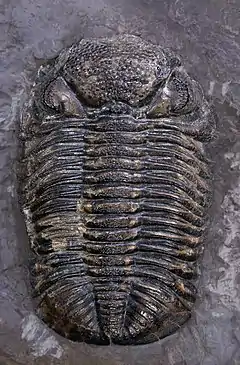 | |
| Greenops | G. aequituberculatus | Dock Street clay member.[7] | Also found in the Norway Point and Gravel Point formations. | ||
| G. traversensis | Dock Street clay member.[7] | Also found in the Gravel Point Formation. | |||
| Phacops | P. rana | [7] | Reassigned to the genus Eldredgeops. | ||
| Proetus | P. (Crassiproetus) traversensis | [7] | Also known from the Gravel Point Formation. | ||
References
- Stack, Jack; Sallan, Lauren (2018-09-20). "An examination of the Devonian fishes of Michigan". PeerJ. 6 (2). doi:10.7717/peerj.5636.
- Tyler, John H. (1965). "Gastropods from the Middle Devonian Four Mile Dam Limestone (Hamilton) of Michigan". Journal of Paleontology. 39 (3): 341–349. ISSN 0022-3360.
- Orr, R. William (1971). "Conodonts from Middle Devonian Strata from the Michigan Basin".
{{cite journal}}: Cite journal requires|journal=(help) - Imbrie, John (1959). "Brachiopods of the Traverse group (Devonian) of Michigan. Part 1, Dalmanellacea, Pentameracea, Strophomenacea, Orthotetacea, Chonetacea, and Productacea. Bulletin of the AMNH ; v. 116, article 4".
{{cite journal}}: Cite journal requires|journal=(help) - Watkins, J. Lloyd (1959). "Middle Devonian Auloporid Corals from the Traverse Group of Michigan". Journal of Paleontology. 33 (5): 793–808. ISSN 0022-3360.
- Tyler, John H. (1964). "Anostylostroma anacolumna n. sp. from the Four Mile Dam Limestone (Hamilton), Alpena County, Michigan". Journal of Paleontology. 38 (5): 885–886. ISSN 0022-3360.
- Stumm, Erwin (1953). "Trilobites of the Devonian Traverse Group of Michigan" (PDF). University of Michigan Press - Museum of Paleontology.
- Various Contributors to the Paleobiology Database. "Fossilworks: Gateway to the Paleobiology Database". Retrieved 17 December 2021.
This article is issued from Wikipedia. The text is licensed under Creative Commons - Attribution - Sharealike. Additional terms may apply for the media files.